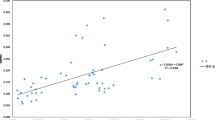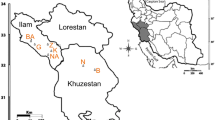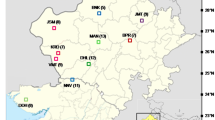Abstract
A simple sequence repeat (SSR) marker was used to assess the genetic diversity and population structure of an endangered relic species Emmenopterys henryi Oliv., endemic to China. A total of 124 samples from six populations were analyzed using eight pairs of SSR primers. Total 114 alleles were detected with an average of 14.3 alleles per locus. The presence of null alleles can result in low genetic diversity parameters (He and allelic richness) for all loci and mostly likely caused the deviation from Hardy–Weinberg equilibrium (HWE). The Polymorphism information content (PIC) values were higher which indicates that selection of SSR markers were suitable choice for assessing the genetic diversity in E. henryi. Our results revealed that the natural populations of E. henryi have a high degree of genetic diversity. Genetic diversity amongst the six E. henryi populations in decreasing order were: GJY > LS > DWS > WYS > HS > JGS. Further, genetic structure and the Neighbor-Joining (NJ) cluster analysis indicated that there were cross-mixing among the 124 samples. Four populations (i.e., HS, DWS, JGS and WYS) were clustered in one group, whereas LS and GJY population were clustered separately as two groups. A Principal Component Analysis (PCA) also showed a similar clustering trend. The results of Fst (0.085) and AMOVA indicated that the genetic variation resided within the populations and existence of frequent gene exchanges among populations. Based on these results, populations with abundant genetic variation and rare alleles should be conserved in situ and ex situ. Furthermore, seeds from the different populations with high levels of genetic diversity could be collected and propagated in order to capture the maximum available genetic diversity. The present study on genetic diversity of E.henryi could be helpful in expanding the understanding on species survival and also for developing an effective long term conservation strategy.





Similar content being viewed by others
References
Agarwal S, Khan S (2019) Genetic diversity of 18 male and 18 female accessions of Jojoba [Simmondsia chinensis (link) Schneider] using EST-SSRs. Meta Gene 19:134–141
Ali A, Pan YB, Wang QN, Wang JD, Chen JL, Gao SJ (2019) Genetic diversity and population structure analysis of Saccharum and Erianthus genera using microsatellite (SSR) markers. Sci Rep 9:395
Barros J, Winkler FM, Velasco LA (2020) Assessing the genetic diversity in Argopecten nucleus (Bivalvia: Pectinidae), a functional hermaphrodite species with extremely low population density and self-fertilization: Effect of null alleles. Ecol Evol 10(9):3919–3931
Belalia N, Lupini A, Djemel A, Morsli A, Mauceri A, Lotti C, Khelifi-Slaoui M, Khelifi L, Sunseri F (2019) Analysis of genetic diversity and population structure in Saharan maize (Zea mays L.) populations using phenotypic traits and SSR markers. Genet Resour Crop Evol 66:243–257
Brookfield JFY (1996) A simple new method for estimating null allele frequency from heterozygote deficiency. Mol Ecol 5:453–455
Chen C, Qi ZC, Xu XH, Comes HP, Koch MA, Jin XJ, Fu CX, Qiu YX (2014) Understanding the formation of Mediterranean-African disjunctions: evidence for Miocene climate-driven vicariance and recent long-distance dispersal in the Tertiary relict Smilax aspera (Smilacaeae). New Phytol 204:243–255
Cheng DM (2008) Study on the pollination biology of the state key protected species. Master’s thesis. Henan Agricultural University
Doyle JJ, Doyle JL (1987) A rapid DNA isolation procedure for small quantities of fresh leaf tissue. Phytochem Bull 19:11–15
Earl DA, vonHoldt BM (2012) Structure harvester: a website and program for visualizing structure output and implementing the Evanno method. Conserv Genet Resour 4:359–361
Evanno G, Regnaut S, Goudet J (2005) Detecting the number of clusters of individuals using the software STRUCTURE: a simulation study. Mol Ecol 14:2611–2620
Guo LN, Gao XF (2017) Genetic diversity and population structure of Indigofera szechuensis complex (Fabaceae) based on EST-SSR markers. Gene 624:26–33
Guo LJ, Li M (2009) Fractal analysis of the distribution pattern of an endangered plant, Emmenopterys henryi population in Wuyi mountain. Acta Bot Bor-Occid Sin 29:0867–0873
Guo LJ, Lin LW, Xiu WH, Wang AP (2011a) Characteristics of reproductive modules of E henryi natural population in Wuyi mountain. J Northwest Forest Univ 26(4):18–22
Guo N, Yang SH, Ge WY, Ge H (2011b) Phenotypic diversity of natural populations of Rosa laxa Retz in Tianshan Mountains of Xinjiang. Acta Hort Sin 38(3):495–502
Hu HQ, Cui TL (2011) Utilization value and cultivation techniques of Emmenopterys henryi. Forest Product Spec China 1:10. https://doi.org/10.13268/j.cnki.fbsic.2011.06.044
Ilves A, Lanno K, Sammul M, Tali K (2013) Genetic variability, population size and reproduction potential in Ligularia sibirica (L.) populations in Estonia. Conserv Genet 14:661–669
Kalinowski ST (2005) HP-RARE 1.0: a computer program for performing rarefaction on measures of allelic richness. Mol Ecol Notes 5:187–189
Kirk H, Freeland JR (2011) Applications and implications of neutral versus non-neutral markers in molecular ecology. Int J Mol Sci 12:3966–3988
Letunic I, Bork P (2016) Interactive tree of life (iTOL) V3: an online tool for the display and annotation of phylogenetic and other trees. Nucleic Acids Res 8(44):242–245
Li YY (2017) Studies on conservation genetics of Chinese endemic speciesLuculia yunnanensis Hu. Ph. D. Chinese Academy of Forestry
Li TQ (2018) Conservation biology of the plant species with extremely small population Rhododendron longipedicellatum. Master Degree, Chinese Academy of Forestry
Li JM, Jin ZX (2004) Optimization of the RAPD conditions of Emmenopterys henryi and prrmary study on the genetic diversity. J. Fujian For Sci-Tech 31(2):36–40
Li JM, Jin ZX (2006) Optimization and screening of ISSR reaction system in endangered plant Emmenopterys henryi. J Anhui Agricult Univ 33(4):458–461
Liu YF, Xing M, Zhao W, Fan RJ, Luo S, Chen X (2012) Genetic diversity analysis of Rhododendron aureum George (Ericaceae) located on Changbai Mountain using ISSR and RAPD markers. Plant Syst Evol 298(5):921–930
Liu QW, Song Y, Liu L, Zhang MY, Sun JM, Zhang SL, Wu J (2015) Genetic diversity and population structure of pear (Pyrus spp) collections revealed by a set of core genome-wide SSR markers. Tree Genet Genomes 11:128
Lu W, Tang ZS, Zheng ZJ, Ye GH, Chen SW, Wang YQ, Ye D, Liu P, Chen JH (2018) The community composition and structural characteristics of Emmenopterys henryi forest, an endangered species in Gutianshan, zhejiang province. Ecol Environ Sci 27(6):1052–1059
Ma WW, Zhai SN, Zhang YH, Qiu YX (2012) Development and characterization of microsatellite markers for Emmenopterys henryi (Rubiaceae), a rare tree from china. Am J Bot 99(4):179–181
Ma MW, Wu YH, Zhang Y, Kang HJ, Chen ZL, Liu P (2018) Sprouting as a survival strategy for non-coniferous trees: Relation to population structure and spatial pattern of Emmenopterys henryi (Rubiales). Acta Ecola Sin 39:1–8
Man JS, Fang YP, Liu SX, Peng ZL (2008) The resource and protection of Emmenopterys henryi in Qizimei-shan National Nature Preserve. China. J Huanggang Normal Univ 28(3):44–46
McNamara W (2005) Emmenopterys henryi. Pacific Horticul 4(66):39–40
Ming L, Zhong Z, Xingjun M, Jingjing Z (2013) Genetic diversity and population structure of Siberian apri-cot (Prunus sibirica L.) in China. Int J Mol Sci 15:377–400
Montgomery ME, Woodworth LM, Nurthen RK, Gilligan DM, Briscoe DA, Frankham R (2000) Relationship between population size and loss of genetic diversity: comparisons of experimental results with theoretical predictions. Conserv Genet 1(1):33–43
Nakintu J, Albrecht C, Muller MC, Kagoro-Rugunda G, Andama M, Olet EA, Lejju JB (2020) Exploring the genetic diversity of jackfruit (Artocarpus heterophyllus Lam.) grown in Uganda based on SSR markers. Genet Resour Evol 67:605–619
Niu YL, Peng YS, Song L, Zhou SX, Wei ZX, Song MZ, Huang J, Zhang PX, Gao PX, Du J, Yu ZJ (2017) Establishment of reaction system and primer screening for SRAP marker on endangered plant Emmenopterys henryi. Mol plant breed 15(8):3136–3144
Nybom H (2004) Comparison of different nuclear DNA markers for estimating intraspecific genetic diversity in plants. Mol Eco 13(5):1143–1155
Paetkau D, Strobeck C (1995) The molecular basis and evolutionary history of a microsatellite null allele in bears. Mol Ecol 4:519–520
Peakall R, Smouse PE (2012) GenAlEx 6.5: genetic analysis in Excel. Population genetic software for teaching and research-an update. Bioinformatics 28:2537–2539
Powell W, Morgante M, Andre C, Hanafey M, Vogel J, Tingey S, Rafalski A (1996) The comparision of RFLP, RAPD, AFLP and SSR (microsatelite) markers for germplasm analysis. Mol Breeding 2:225–238
Pritchard JK, Stephens M, Donnelly P (2000) Inference of population structure using multilocus genotype data. Genetics 7:574–578
Qi XS, Chen C, Comes HP, Sakaguchi S, Liu YH, Tanaka N, Sakio H, Qiu YX (2012) Molecular data and ecological niche modeling reveal a highly dynamic evolutionary history of the East Asian Tertiary relict Cercidiphyllum (Cercidiphyllaceae). New Phytol 196:617–630
Qian S, SaitoW Mimura M, Kaneko S, Isagi Y, Mizumachi E, Mori AS (2014) Asymmetric gene flow and the distribution of genetic diversity in morphologically distinct Abies mariesii populations in contrasting eco-habitats. Plant Ecol 215:1385–1397
Rohini MR, Sankaran M, Rajkumar S, Prakash K, Gaikwad A, Chaudhury R, Malik SK (2020) Morphological characterization and analysis of genetic diversity and population structure in Citrus X jambhiri Lush. Using SSR markers. Genet Resour Crop Evol. https. https://doi.org/10.1007/s10722-020-00909-4
Sebastien L, Julie J, Francois H (2008) FactoMineR: an R package for multivariate analysis. J Statist Soft Ware 25:1–18
Shahabzadeh Z, Mohammadi R, Darvishzadeh R, Jaffari M (2020) Genetic structure and diversity analysis of tall fescue populations by EST-SSR and ISSR markers. Mol Bio Rep 47:655–669
Song J, Li SF, Liu LN, Li SF, Xie WJ, Guan WL (2013) Phenotypic diversity of natural populations of Michelia yunnanensis. Acta Bot Boreal-Occident Sin 33(2):272–279
Van Oosterhout C, Hutchinson WF, Wills DPM, Shipley P (2004) MICRO-CHECKER: software for identifying and correcting genotyping errors in microsatellite data. Mol Ecol Notes 4:535–538
Wright S (1965) The interpretation of population structure by F-statistics with special regard to systems of mating. Evolution 19:395–420
Wu FQ, Shen SK, Zhang X, Yang GS, Wang YH (2017) Inferences of genetic structure and demographic history of Rhododendron protistum var giganteum—the world’s largest Rhododendron using microsatellite markers. Flora 233:1–6
Xiong D, Chen FJ, Li XP, Liang HW, He ZQ (2006) Genetic diversity of endangered Emmenopterys in Shennongjia Region of Hubei Province. Acta Bot Bor-Occid Sin 26(6):1272–1276
Yang KJ, Zhang XP (2007) Research advances of rare plant Emmenopterys henryi Oliy. Chin Wild Plant Resour 26(2):1–4
Zhang YH (2016) Phylogeography and landscape genetics of Emmenopterys henryi (Rubiaceae), a Tertiary relict species across China. Zhejiang University, Ph.D.Degree
Zhang WB, Jin ZX, Li JM (2007) Analysis of genetic diversity in the natural population of Emmenopterys henryi using RAPD. J Zhejiang Univ 33(1):61–67
Zhang YH, Wang IJ, Comes HP, Peng H, Qiu YX (2016) Contributions of historical and contemporary geographic and environmental factors to phylogeographic structure in a Tertiary relict species, Emmenopterys henryi (Rubiaceae). Sci Rep 6:24041
Zhou HB (2011) Studies on the Chemical Constituents and Bioactivity of Emmenopterys henryi Oliv. Master’s thesis. The Second Military Medical University
Acknowledgements
This work was supported by the National Natural Science Foundation of China (No. 31460078), Natural Science Foundation Project of Jiangxi Province (20122BAB214031), Major National Science & Technology Specific Projects of China (2013FY11150-2-3) and Key Ministry Projects of Chinese Academy of Sciences (KFJ-3 W-N01). We are also very grateful to Dr. Syd Ramdhani Srinivasan, University of KwaZulu-Natal (UKZN),South Africa, for his critical revision of a final version of themanuscript.
Author information
Authors and Affiliations
Contributions
YL Niu conceived and designed the experiment; YS Peng, XH Zhan,Y Gao, ZY Zhang and W Hu performed the experiments; WX Chen, AB, MZ Song and ZJ Yu analyzed the data; YL Niu, WX Chen, MZ Song, ZJ Yu and AB wrote the manuscript.
Corresponding author
Ethics declarations
Conflict of interest
The authors declare that they have no conflict of interest.
Additional information
Publisher's Note
Springer Nature remains neutral with regard to jurisdictional claims in published maps and institutional affiliations.
Rights and permissions
About this article
Cite this article
Niu, Y., Bhatt, A., Peng, Y. et al. Genetic diversity and population structure analysis of Emmenopterys henryi Oliv., an endangered relic species endemic to China. Genet Resour Crop Evol 68, 1135–1148 (2021). https://doi.org/10.1007/s10722-020-01054-8
Received:
Accepted:
Published:
Issue Date:
DOI: https://doi.org/10.1007/s10722-020-01054-8




